Shards, by Bruce Baugh (White Wolf, 2002)
Shadows, by Bruce Baugh (White Wolf, 2002)
Sacrifices, by Bruce Baugh, (White Wolf, 2002)
The Madness of Priests, by Philippe Boulle (White Wolf, 2003)
Agyar, by Steven Brust (Tor, 1993)
Darkest Heart, by Nancy A. Collins (White Wolf, 2002)
Lady Crymsyn, P.N. Elrod (Ace, 2000)
Cold Streets, by P.N. Elrod (Ace, 2003)
Dhampir, by Barb and J.C. Hendee, (Roc, 2003)
The Ultimate Dracula, edited by Byron Priess (iBooks, 2003)
The Best of Dreams of Decadence, edited by Angela Kessler (Roc, 2003)
As I write this, it’s late April, and in the U.S., Tax Season has once again passed. And perhaps coincidentally, that got me to thinking about a different, more classical, sort of bloodsucker. Looking around my desk, I realized that somehow, a few vampire books had piled up. I swear, they probably bite other books and turn them into vampires when I’m not looking. I can see it now. In the dead of night, when I’m upstairs sleeping the sleep of the innocent and dreaming of those halcyon days when I read without reviewing, as a simple shaft of moonlight arcs over my desk, the books … come to life. They sprout fangs and bat wings, and take to the ceiling. There, they confer in the sound of rustling pages. Finally, without warning, one of Laurell K. Hamilton’s books dives down, seizing some poor misshelved Tolkein ripoff, and drinking deep of its ink. In the morning, the book is gone, but in its place sits another vampire novel, freshly reborn….
Pardon me. I got carried away. The fact remains, I found, without even trying, no less than eleven vampire novels of assorted inspirations and lineages, and thought it might be prudent to “deal” with them all at once, before they could convert any more hapless romances or reference books to their evil cause. And believe me, they do come from a variety of sources. Almost half of the list were published by White Wolf, which made its name for itself as a gaming studio with the popular Vampire: The Masquerade. Of these, three books are inspired by the main line, and another by its spinoff, Victorian Age Vampire. Another two books come from P.N. Elrod’s long-running Vampire Files series, about 1930’s-era private investigator-turned-vampire-turned-nightclub owner Jack Fleming. To round the list out, there’s one not-so-traditional fantasy, and a pair of anthologies. All in all, it’s a nice roundup. And on with the blood-sucking show.
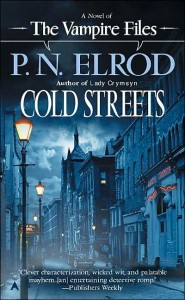
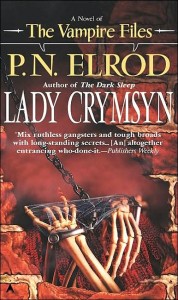 In Lady Crymsyn, the eighth book in P.N. Elrod’s Vampire Files series, the year is 1937, and Chicago’s a dangerous place to live. If you don’t believe it, ask Jack Fleming, vampire private investigator. Thanks to some “business” in previous books, he’s come into enough money to finally open up that nightclub he’s always dreamed of. Unfortunately, things don’t go as planned, when, during the remodeling of the speakeasy he’s acquired, a body is discovered in the basement. A body in a distinctive red dress, handcuffed and walled up. Whoever this woman was, whatever happened to bring her to this place, she clearly died horribly. And Jack Fleming, P.I., vampire, and knight in tarnished armor, dedicates himself to solving the mystery of the woman. Who she was, who killed her, and why. It’ll take all of his powers and wits to solve a mystery that’s been closed (or walled away) for years, especially in a city like Chicago, which already has its fair share of skeletons in the closet. Good thing Jack’s got friends. He’ll need them. Toss in a pesky ghost, trouble with the mobs (as usual) and even a vampire may find himself in danger.
In Lady Crymsyn, the eighth book in P.N. Elrod’s Vampire Files series, the year is 1937, and Chicago’s a dangerous place to live. If you don’t believe it, ask Jack Fleming, vampire private investigator. Thanks to some “business” in previous books, he’s come into enough money to finally open up that nightclub he’s always dreamed of. Unfortunately, things don’t go as planned, when, during the remodeling of the speakeasy he’s acquired, a body is discovered in the basement. A body in a distinctive red dress, handcuffed and walled up. Whoever this woman was, whatever happened to bring her to this place, she clearly died horribly. And Jack Fleming, P.I., vampire, and knight in tarnished armor, dedicates himself to solving the mystery of the woman. Who she was, who killed her, and why. It’ll take all of his powers and wits to solve a mystery that’s been closed (or walled away) for years, especially in a city like Chicago, which already has its fair share of skeletons in the closet. Good thing Jack’s got friends. He’ll need them. Toss in a pesky ghost, trouble with the mobs (as usual) and even a vampire may find himself in danger.
In Cold Streets, Jack’s back and business is booming at his nightclub. Thanks to some influential friends in the mob business, and his own vampiric powers of persuasion, he’s turned it into a place to be proud of, where everyone’s happy and the drinks are flowing. Unfortunately, that white knight streak of his is about to get him in trouble. When he helps to foil a kidnapping, he becomes the target of a nasty blackmail attempt, by someone willing to expose his secret to the world. Meanwhile, a new player from New York’s in town to take over for Jack’s friend, Gordy, who runs the local mob. “Hog” Bristow has no respect for the niceties of negotiation, or for the supposed neutrality of Lady Crymsyn. Between blackmail and gunfire, Jack and his partner, Escott, will be working overtime. But will Jack lose his grip on humanity once and for all, when things turn ugly?
Elrod certainly has an interesting thing going here. I’m reminded a bit of Jim Butcher’s Dresden Files, in that the main character is a supernaturally-empowered P.I. with too much honor and not enough common sense for his own good. The books are atmospheric, and she really makes the time period and setting of late ’30s Chicago come alive, playing up the culture and historical backdrop. However, while the main character might be a vampire, it doesn’t really give off that vampire vibe. Jack wholeheartedly uses his powers to vanish, and to hypnotize, and even play around with strength and speed, but he has too much of a grip on his human self. There are times when he feels more like a mortal with special powers, than a romantic, bloodsucking figure of the night. I’m not so sure that the juxtaposition really works with him. He does hardboiled detective wonderfully, Jack does, but he doesn’t make the most intriguing of vampires.
It’s a shame I’m dissatisfied with that aspect of the series, because the two books I’ve read were compelling and complex, and quite enjoyable. They’re about 95% accessible to readers who haven’t seen the first seven or so in the series, which is good since it’s not easy to find the earlier books in the stores I’ve checked. Admittedly, there are interpersonal relationships, and events early on that influence how things unfold now, but the astute reader will catch up in no time. So all in all, Lady Crymsyn and Cold Streets are both wonderfully-written, dark (even noir) novels that are worth checking out if you like the supernatural P.I. subgenre (like I do), but as vampire novels, they come off a little weak in comparison to some of the others on my list.
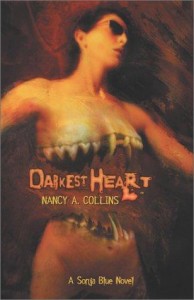 Where the Jack Fleming books come off as a bit too familiar in terms of the vampire main character, Nancy Collin’s Darkest Heart, the newest Sonja Blue novel, treasts the vampire as something truly alien and monstrous. Sonja Blue is an unwilling vampire, possessed by a creature she calls “The Other”, a bloodthirsty beast that tears apart its prey, and does horrible things in the name of existence. Sonja exists in a world of restraint and self-loathing, slaying her fellow vampires and denying The Other its urges as best she can. Her world is a darkly supernatural funhouse, with demons and werewolves and much, much worse dwelling in the shadows.
Where the Jack Fleming books come off as a bit too familiar in terms of the vampire main character, Nancy Collin’s Darkest Heart, the newest Sonja Blue novel, treasts the vampire as something truly alien and monstrous. Sonja Blue is an unwilling vampire, possessed by a creature she calls “The Other”, a bloodthirsty beast that tears apart its prey, and does horrible things in the name of existence. Sonja exists in a world of restraint and self-loathing, slaying her fellow vampires and denying The Other its urges as best she can. Her world is a darkly supernatural funhouse, with demons and werewolves and much, much worse dwelling in the shadows.
For the sake of love and her humanity, Sonja is willing to die. But she’s not that lucky. Her attempt to chain The Other once and for all is, ultimately, a failure, and Sonja is forced to walk once more. There’s another vampire hunter out there, and his path is set to cross hers. Together, they’ll take on an ancient vampire and his assorted dark minions, unholy abominations and things that shouldn’t exist. They’ll challenge the boundaries of life and death, and Sonja will risk everything to atone for her mistakes.
Nancy Collins has the atmosphere down pat, and she captures the horrifying, addictively sensual, violent, ugly, Goth-romantic aspect of the vampire mythos with sadistic glee, tormenting the characters until they beg for mercy. Darkest Heart is morbidly fascinating, like an auto accident, or a gunshot wound on the news. I couldn’t put it down. This is hardcore vampire with all the blood and guts and nastiness you could ever want.
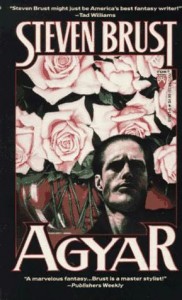
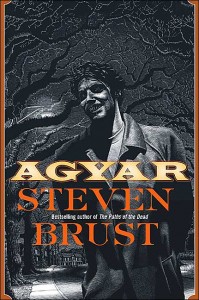 How long can you go with a vampiric protagonist without actually saying as much? How about an entire book? That’s what Steven Brust as much as does in Agyar, a skillfully-woven tale of passion, obsession, and desire that makes me wish I hadn’t already used my quota of the word “dark”. Agyar (he goes by a number of names, but this is his most common) is a drifter, a wanderer, a mysterious stranger who takes up residence in a haunted house in an Ohio college town. His story unfolds slowly, blossoming like some midnight flower, and we see firsthand the events that cause his well-ordered life to spiral into chaos. All for the sake of a woman, one might say. When he takes the wrong woman as a lover and a vessel from which to drink, he soon discovers that he’s brought new enemies into his life. What will Agyar do to protect himself, and to protect the girl he cares for? Ah, but that would be telling. The plot is deceptively simple, the writing evocative and sharp, and the characters fascinating. Agyar is almost the perfect “unvampire” novel, avoiding the term as much as it does, and conjuring up enough images to let the reader draw their own conclusions. This is definitely one of Brust’s best works, a rare departure from the more traditional fantasy (can anyone call the Taltos series traditional?) into the realm of horror. It’s hard to go into more detail without spoiling something vital. However, he manages to obtain a splendid blend of mystery and horror and romance, playing on the allure of the unknown and the magic of the concept. Try this one on the people who claim they don’t like vampires, and see what they say afterwards.
How long can you go with a vampiric protagonist without actually saying as much? How about an entire book? That’s what Steven Brust as much as does in Agyar, a skillfully-woven tale of passion, obsession, and desire that makes me wish I hadn’t already used my quota of the word “dark”. Agyar (he goes by a number of names, but this is his most common) is a drifter, a wanderer, a mysterious stranger who takes up residence in a haunted house in an Ohio college town. His story unfolds slowly, blossoming like some midnight flower, and we see firsthand the events that cause his well-ordered life to spiral into chaos. All for the sake of a woman, one might say. When he takes the wrong woman as a lover and a vessel from which to drink, he soon discovers that he’s brought new enemies into his life. What will Agyar do to protect himself, and to protect the girl he cares for? Ah, but that would be telling. The plot is deceptively simple, the writing evocative and sharp, and the characters fascinating. Agyar is almost the perfect “unvampire” novel, avoiding the term as much as it does, and conjuring up enough images to let the reader draw their own conclusions. This is definitely one of Brust’s best works, a rare departure from the more traditional fantasy (can anyone call the Taltos series traditional?) into the realm of horror. It’s hard to go into more detail without spoiling something vital. However, he manages to obtain a splendid blend of mystery and horror and romance, playing on the allure of the unknown and the magic of the concept. Try this one on the people who claim they don’t like vampires, and see what they say afterwards.

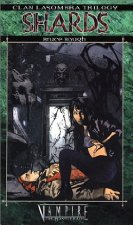
 Shadows, Shards, and Sacrifices make up the Clan Lasombra trilogy, based on White Wolf’s flagship game, Vampire: The Masquerade. To give you some backstory, the first murderer (Caine) was also the first vampire, cursed by God. All vampires can trace themselves back to him, though they divide themselves into Clans, each one having shared strengths and weaknesses, all but a few exceptions tracing their lineage back to the so-called Third Generation. The older the vampire, the more powerful and more inhuman they’ve become. Furthermore, the majority are associated with one of two societies: the Camarilla (who advocate humanity’s ignorance) and the Sabbat (who advocate humanity’s enslavement). Admittedly, those viewpoints are rather simplified. As it stands, Vampire tried to balance the political mechinations of the older vampires, with the struggle to retain the humanity of the younger ones.
Shadows, Shards, and Sacrifices make up the Clan Lasombra trilogy, based on White Wolf’s flagship game, Vampire: The Masquerade. To give you some backstory, the first murderer (Caine) was also the first vampire, cursed by God. All vampires can trace themselves back to him, though they divide themselves into Clans, each one having shared strengths and weaknesses, all but a few exceptions tracing their lineage back to the so-called Third Generation. The older the vampire, the more powerful and more inhuman they’ve become. Furthermore, the majority are associated with one of two societies: the Camarilla (who advocate humanity’s ignorance) and the Sabbat (who advocate humanity’s enslavement). Admittedly, those viewpoints are rather simplified. As it stands, Vampire tried to balance the political mechinations of the older vampires, with the struggle to retain the humanity of the younger ones.
A few years back, White Wolf released their Clan Novels series, a thirteen book series that brought upheaval to their setting. Spinning out of this is Clan Trilogy: Lasombra, which features one of the pivotal characters from the first series, Lucita, a thousand-year-old member of Clan Lasombra, whose members control and have an affinity for shadows, and who act as a mainstay of the Sabbat. At long last, Lucita is free of her powerful sire, the inhuman vampire known as Moncada. For her, it’s a blessed release. For the rest of her Clan, it’s trouble waiting to happen. They’ll do anything to find and eliminate the threat they percieve her as. But other, darker, deadlier plans are afoot in the Lasombra, including an attempt to resurrect their long-dead founder and namesake, a creature of unimaginable power and appetite which could destroy them all before turning them into dinner.
The Clan Lasombra trilogy has some good things, and some bad things, going for it. On the positive side, Bruce Baugh really does capture the inhumanity and the complex plotting of these immortal creatures. He also has the setting down pat, able to produce a multi-layered, intriguing tale set in the World of Darkness. This series, and the setting, really do play up the bizarre nature and stranger powers of the vampires, as well as the detachment they begin to feel as their affinity for humanity slips away over centuries or millenia, and their slow evolution into something far more terrifying. As well, we see what sort of mechinations and plots can come about when one has eternity to plan and the patience to outlive his enemies. On the down side, I felt that this series wasn’t the best one for newcomers to the setting to start with. Not only does the trilogy spin out of another series, but it seems to assume at least a passing familiarity with the source material. I hadn’t read the Clan Novel: Lasombra, and so felt a little behind the times for this, despite the promising premise and Baugh’s obvious skills. The Clan Lasombra trilogy is moody and complex, and a great series for those already well-versed with the World of Darkness, but it’s not one I’d choose to initiate non-fans with.
 On the other hand, there’s the second book in the Victorian Age Vampire trilogy, The Madness of Priests by Philippe Boulle. Continuing the bizarre adventures of Regina Blake as she attempts to save her mother from a dangerous society of vampiric blood sorcerers, this book sees Regina and her mentor, Victoria Ash, descend further into a world of hidden sins and private damnations. Vampires are real, and they mimic the surface world with a mock court, paying homage to a Prince of their very own, tugging the strings of mortal society with an eye towards preserving their own existence, and making it more comfortable. Secret societies abound in this last years of the 19th Century, not all of them run by humans. Caught up in all of this are Regina’s father, and her fiancee, who may already have been lost to the seductive schemes of one such group. Little does Regina know the true purpose her mother, once thought dead, now known to be entrapped by the vampires known as the Order of Tremere, has been groomed for. When Regina stumbles across a vampiric religious fanatic, the charismatic Father Anatole, her quest could end prematurely.
On the other hand, there’s the second book in the Victorian Age Vampire trilogy, The Madness of Priests by Philippe Boulle. Continuing the bizarre adventures of Regina Blake as she attempts to save her mother from a dangerous society of vampiric blood sorcerers, this book sees Regina and her mentor, Victoria Ash, descend further into a world of hidden sins and private damnations. Vampires are real, and they mimic the surface world with a mock court, paying homage to a Prince of their very own, tugging the strings of mortal society with an eye towards preserving their own existence, and making it more comfortable. Secret societies abound in this last years of the 19th Century, not all of them run by humans. Caught up in all of this are Regina’s father, and her fiancee, who may already have been lost to the seductive schemes of one such group. Little does Regina know the true purpose her mother, once thought dead, now known to be entrapped by the vampires known as the Order of Tremere, has been groomed for. When Regina stumbles across a vampiric religious fanatic, the charismatic Father Anatole, her quest could end prematurely.
Even someone not familiar with the World of Darkness setting can pick up on the material in no time, here. Even though we’re treated to a much more in-depth study of vampiric society, it’s generally done with one of a few outsiders, including Regina, as the point of view characters. Through her eyes, it’s all a little stranger and more exotic, secrets of the Victorian age hidden behind a half-drawn curtain. It helps to start with the first in the trilogy, A Morbid Initiation, but even so, this is a nicely accessible book. It invokes a number of Victorian themes, including repressed eroticism, the fascination with the occult, the fascination with farflung lands like Egypt or India, and of course, that day/night dichotomy. Anyone who likes their vampires “classic” will probably get a kick out of this series.
Another recent find, Dhampir by Barb and J.C. Hendee, is interesting for a rather different take on the vampire mythos, as well as for translating them over to a pure fantasy setting. For some reason, vampires work best when posed against the modern world, so it’s always disconcerting to see them in a fantasy or even science fiction world. In this case, it seems to work.
Magiere and her partner, the half-elf Leesil, wander the land, acting as vampire slayers for hire, taking whatever the grateful villagers can afford to pay her in exchange for ridding them of the nocturnal horrors that stalk them. However, what no one realizes is that for all the flash and show and effort, Magiere and Leesil are really, quite simply, running a con game. There are no vampires. There’s only Magiere, Leesil, and their canine companion, Chap. But after years of the game, Magiere’s ready to settle down, buy a tavern, and live an honest life for once. Leesil, less thrifty, is none too pleased by this, but would rather stay with his only friend than leave her. So it’s off to the city of Miiska, and to that honest life.
Small problem. Miiska is home to a pack of powerful vampires, and they’re definitely unhappy to have a vampire slayer moving into town. Magiere will have to live up to the reputation she falsely created, master abilities she never knew she possessed, and tap into her heritage to destroy the monsters of Miiska. Luckily, she has Leesil, whose own history is shadowed and more dangerous then he ever let on, and Chap, who’s more than a mere dog, to back her up. As well, there’s a stranger who knows more about Magiere than she herself does, and he has his own agenda for vampires and slayer alike.
Dhampir is a clever and well-told tale that has more than a few twists, the least of which is the one spoiled above. Set up to allow sequels, it’s still a great stand-alone that finds a fairly new way to approach vampires in a believable fantasy world that oozes with atmosphere and begs for more exploration. I thoroughly enjoyed it, and I’m hoping we’ll see more from the Hendees soon.
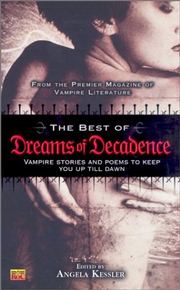
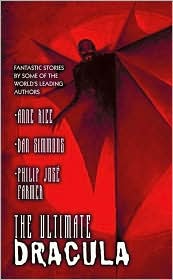
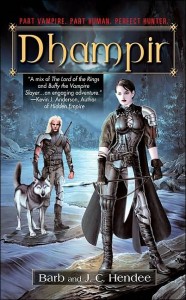 If there was a championship title bout among vampires, then the undisputed champion through sheer popularity, staying power, number of interpretations, and cultural recognition would clearly be Dracula. That’s why it’s hardly surprising to see The Ultimate Dracula, an anthology released by iBooks and originally published in 1991. In this collection, Dracula and his legend are retold and reinterpreted by nineteen masters of the genre. Notables include Anne Rice, Philip Jose Farmer, Dan Simmons, Ed Gorman, Lawrence Watt-Evans, Mike Resnick, Kristine Kathryn Rusch, and John Gregory Betancourt. Leonard Wolf’s insightful and information introduction, and a selected filmography detailing some of the best or more noteworthy versions of Dracula to hit the silver screen, are added bonuses for the anthology. Though every anthology is naturally touch and go, hit and miss, according to individual tastes, this particular collection has a rather nice number of standout talents, and enough variety among authors and stories to appeal to almost any fan of the vampire genre. Noteworthy stories, in my mind, include Edward Hoch’s chillingly historic “Dracula 1944″, which has the Lord of the Vampires visiting a Nazi work camp during the later part of World War II, and Heather Graham’s fang-in-cheek “The Vampire In His Closet”, where a writer goes looking for inspiration. These stories represent the opposite ends of the thematic and mood spectrum one’ll find in The Ultimate Dracula.
If there was a championship title bout among vampires, then the undisputed champion through sheer popularity, staying power, number of interpretations, and cultural recognition would clearly be Dracula. That’s why it’s hardly surprising to see The Ultimate Dracula, an anthology released by iBooks and originally published in 1991. In this collection, Dracula and his legend are retold and reinterpreted by nineteen masters of the genre. Notables include Anne Rice, Philip Jose Farmer, Dan Simmons, Ed Gorman, Lawrence Watt-Evans, Mike Resnick, Kristine Kathryn Rusch, and John Gregory Betancourt. Leonard Wolf’s insightful and information introduction, and a selected filmography detailing some of the best or more noteworthy versions of Dracula to hit the silver screen, are added bonuses for the anthology. Though every anthology is naturally touch and go, hit and miss, according to individual tastes, this particular collection has a rather nice number of standout talents, and enough variety among authors and stories to appeal to almost any fan of the vampire genre. Noteworthy stories, in my mind, include Edward Hoch’s chillingly historic “Dracula 1944″, which has the Lord of the Vampires visiting a Nazi work camp during the later part of World War II, and Heather Graham’s fang-in-cheek “The Vampire In His Closet”, where a writer goes looking for inspiration. These stories represent the opposite ends of the thematic and mood spectrum one’ll find in The Ultimate Dracula.
Last, but certainly not least, in this parade of the damned, is The Best of Dreams of Decadence. Dreams of Decadence is a vampire-only poetry and fiction magazine that’s been around for the better part opf a decade, acting as one of the flagship titles for DNA Publications, which also owns Weird Tales. Over the years, it’s changed size and format, always getting larger and better, and for a while it routinely sold out through the Hot Topics chain of ‘trend’ stores, until Hot Topics themselves started moving away from the Gothic focus. Collected here are some of the very best of a consistently quality vampire magazine, which is, if not one of a kind, at least one of the more persistent and notable of its kind. Authors represented include Sarah A. Hoyt, Sharon Lee, Wendy Rathbone, Laura Anne Gilman, Tippi N. Blevins, Tanith Lee, Lawrence Watt-Evans, Josepha Sherman, Brian Stableford, and DNA Publications publisher Warren Lapine. All in all, several dozen stories and poems are presented, in most cases reprinted for the very first time, and they really do represent the vast potential of the vampire genre. If you like vampires, and you like variety, this collection may be right up your alley. It’s got something for everyone, and it proves there’s still way too much life left in an undead field.
Now if you’ll excuse me, I hear my books calling. They demand … fresh victims.
